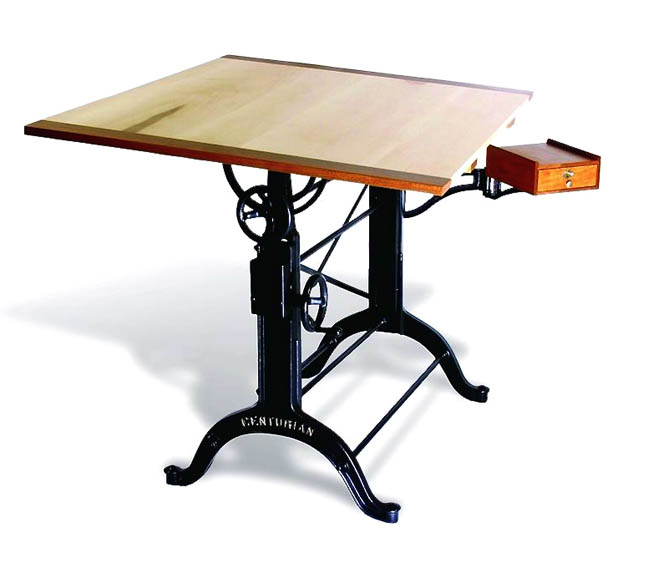

Title: Industrial Centurian Mechanical Cast-Iron Base Drawing Table
Shipping: $250.00
Artist: N/A
Period: Contemporary
History: N/A
Origin: North America > United States
Condition: Excellent
Item Date: 2008
Item ID: 1477
Beautiful victorian mechanical drawing table with adjustable cast-iron base, cherry/maple drawing board, and matching cherry tool drawer. The table's height and tilt are easily adjusted to meet the ergonomic needs of any potential owner. Its cast-iron base provides a superbly stable work surface. Beautifully finished, well suited for both home and office environments.
Link: http://en.wikipedia.org/wiki/Drawing_board
A drawing board (also drawing table, drafting table or architect's table) is, in its antique form, a kind of multipurpose desk which can be used for any kind of drawing, writing or impromptu sketching on a large sheet of paper or for reading a large format book or other oversized document or for drafting precise technical illustrations. The drawing table used to be a frequent companion to a pedestal desk in a gentleman's study or private library, during the preindustrial and early industrial era. During the Industrial Revolution draftsmanship gradually became a specialized trade and drawing tables slowly moved out of the libraries and offices of most gentlemen. They became more utilitarian and were built of steel and plastic instead of fine woods and brass. More recently engineers and draftsmen use the drawing board for making and modifying drawings on paper with ink or pencil. Different drawing instruments (set square, protractor, etc.) are used on it to draw parallel, perpendicular or oblique lines. A drawing table is also sometimes called a mechanical desk because, for several centuries, most mechanical desks were drawing tables. Unlike the gadgety mechanical desks of the second part of the 18th century, however, the mechanical parts of drawing tables were usually limited to notches, ratchets, and perhaps a few simple gears, or levers or cogs to elevate and incline the working surface. Very often a drawing table could look like a writing table or even a pedestal desk when the working surface was set at the horizontal and the height adjusted to 29 inches, in order to use it as a "normal" desk. The only give-away was usually a lip on one of the sides of the desktop. This lip or edge stopped paper or books from sliding when the surface was given an angle. It was also sometimes used to hold writing implements. When the working surface was extended at its full height, a drawing table could be used as a standing desk.